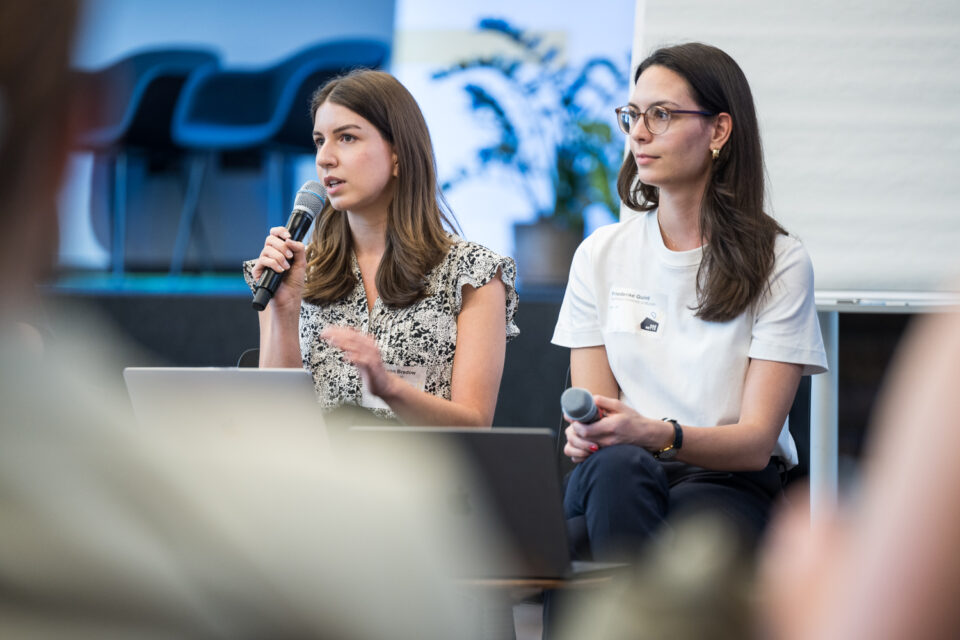TUM Think Tank
Where today's societal challenges meet tomorrow's technological excellence.
 While people across different disciplines are talking about the potential chances and risks of quantum technologies, quantum encryption is one of the domains that will likely have the most direct impact on our society. Our Quantum Cipher Garden offers an artful way to learn about the complex concepts of quantum, such as superposition, which are essential to understand in order to understand quantum encryption. You can immerse yourself into our exhibition and contribute to our unique PuzzleX quantum cipher code. In the end, we encourage you to reflect on the learned and cast your opinion, where will quantum encryption lead us?
While people across different disciplines are talking about the potential chances and risks of quantum technologies, quantum encryption is one of the domains that will likely have the most direct impact on our society. Our Quantum Cipher Garden offers an artful way to learn about the complex concepts of quantum, such as superposition, which are essential to understand in order to understand quantum encryption. You can immerse yourself into our exhibition and contribute to our unique PuzzleX quantum cipher code. In the end, we encourage you to reflect on the learned and cast your opinion, where will quantum encryption lead us?
The Ciphergarden

A Cat between Worlds
A Cat in Superposition
This oddly-looking cat, Schrödi, symbolizes superposition. While cats are generally supposed to be either dead or alive, this cat is both - symbolized by the different colors of the cat’s eye. You might know this phenomenon from Schrödigner’s cat: In his experiment a cat is in a box - until you open the box, you won’t know if it is alive or dead. So while it is in the box, it might be both. Being in more than one state and everything all at once is the imagination behind superposition, one of the key properties of quantum systems. With this piece of art, including a green eye, for a cat being alive and a red eye, a cat being dead we want to show you with an artistic attempt one possible interpretation of superposition.
Superposition - The Physical Phenomenon
To understand that, we leave the world of classical physics for a bit and immerse ourselves more profoundly into the quantum world. Here, particles like photons and electrons exist in superposition states. They are not in one state or another but in many states at once. That is only until you measure them, then the particle collapse into either |0⟩ or |1⟩. For more information see chapter one in quantum computing for the quantum curious.
World and Observer
Collapse of the Wave Function
Here you find another interpretation of superposition - within the cat, we were thinking in particles. One part, which makes it so hard to understand quantum physics is the duality of waves and particles - the duality of the macroscopic and the microscopic world. If we look at the same particles in waves, we can see that one state flows into another state.
Imagine the different colors as liquids floating in each other and now ask yourself: “Which color does this liquid have?” And the superposition stops. The moment you inspect the color, the moment, you give it a name, this moment it is not this beautiful stream anymore, this moment it is just the color you name it, you measure it with your eyes, it is. What has once been a beautiful whirlpool of different colors, just like in our painting, collapses into one state. You force the world into a state through measurement and only a one-color stream leaves it again.
Let’s get to the next aspect. What does this have to do with Quantum Cryptography? One way to harness this essential property of quantum superposition and its collapsing in one state is quantum encryption. Through the distinctive state of quantum particles, two parties can create a unique and unbreakable security code. The BB84 protocol is one quantum key distribution protocol to share a secret key in a safe way, which can be used for encryption.
Quantum Encryption
At Puzzle X 2023 in Barcelona, we have the privilege of presenting a unique and interactive demonstration that showcases the concepts of quantum key distribution. In general, quantum key distribution protocols are algorithms that enable generating a secure key shared between two partners. Our centerpiece at Puzzle X is the Puzzle X Marble Track, a captivating visual representation of the BB84 Protocol, a renowned quantum key distribution algorithm.
The BB84 protocol uses quantum superposition to generate encryption keys, making it nearly impossible for malicious actors to intercept or decipher the message. First, the sender chooses both a bit, zero or one, and one of two types of superposition to encode this bit in a qubit. Then, the qubit is transferred to the receiver. The receiver has no knowledge about the type of superposition the sender chose and therefore randomly assumes one of the two types of superposition when measuring the qubit. The measurement only results in a meaningful result if the receiver chooses the correct superposition. Therefore, usually, the protocol is repeated multiple times such that, with a high probability, the number of qubits measured correctly is sufficient to generate a secure key.
The marble track serves as a playful way to help individuals grasp the intricacies of quantum key distribution. At Puzzle X, we invite the visitors to generate a secure key with the marble track. As demonstrated in the video, visitors participate in the following way:
Choosing a Bit: Visitors start by selecting a bit, zero or one, – represented by a red or blue marble – that they wish to add to the Puzzle X encryption key.
Selecting a Superposition: After choosing their bit, participants decide which type of quantum superposition to use for encoding their selected bit. The marble track offers two distinct channels, each symbolizing a different type of superposition.
Testing Their Luck: The beauty of the Puzzle X Marble Track lies in the element of chance. Participants throw their marbles into their chosen quantum channel while their partner – who has no prior knowledge of their selection – tries to guess which channel they used.
Try Again: If the partner guesses incorrectly, participants can try once more, selecting again marble and quantum channel, thus simulating the unpredictability and complexity of quantum encryption.
Adding to the Puzzle X Cipher Code: If the partner correctly guesses the quantum channel used, the bit goes through, and the participant's contribution becomes part of the Puzzle X cipher code, symbolizing a successful key generation.
On Thursday, at the end of the event, we hope to have a long and unique Puzzle X code created collaboratively by the attendees.
Social Quantum Nexus
As you delve into quantum encryption, you will discover its incredible potential for safeguarding our digital future. However, this technological marvel does not come without social and economic challenges. To give you some overview on different problem fields we provide here an overview:
A. Ethical Considerations
 Quantum encryption has the power to reshape the way we safeguard our digital world, but it also challengesome positive properties of thestatus quo. At the core of standard development should be ethical principles and human rights. Ethical considerations surrounding quantum encryption are intricate, demanding a delicate balancing act. While this technology holds the promise of redefining security and privacy, its responsible use hinges on aligning legal, ethical, and technological principles with precision. It offers unparalleled security for individuals and organizations, yet it introduces complexity in the age-old challenge of striking the right balance between individual privacy and collective security. Responsible use entails transparency in the deployment of quantum encryption since users must be fully informed about how their data is safeguarded, and governments should be transparent about their surveillance and data access practices. Also, governments should create legal frameworks governing the use of quantum encryption to ensure alignment with human rights while addressing security concerns and fostering the positive innovation potential of quantum technologies.
Quantum encryption has the power to reshape the way we safeguard our digital world, but it also challengesome positive properties of thestatus quo. At the core of standard development should be ethical principles and human rights. Ethical considerations surrounding quantum encryption are intricate, demanding a delicate balancing act. While this technology holds the promise of redefining security and privacy, its responsible use hinges on aligning legal, ethical, and technological principles with precision. It offers unparalleled security for individuals and organizations, yet it introduces complexity in the age-old challenge of striking the right balance between individual privacy and collective security. Responsible use entails transparency in the deployment of quantum encryption since users must be fully informed about how their data is safeguarded, and governments should be transparent about their surveillance and data access practices. Also, governments should create legal frameworks governing the use of quantum encryption to ensure alignment with human rights while addressing security concerns and fostering the positive innovation potential of quantum technologies.
B. Costs and Infrastructure
 Implementing quantum encryption, while promising to enhance security, is not without challenges, particularly in terms of costs and infrastructure requirements. Quantum encryption is a cutting-edge field that requires substantial investments in research, development, and deployment. To make it work, we must build an entire quantum infrastructure, complete with quantum critical distribution systems and quantum communication networks.
Implementing quantum encryption, while promising to enhance security, is not without challenges, particularly in terms of costs and infrastructure requirements. Quantum encryption is a cutting-edge field that requires substantial investments in research, development, and deployment. To make it work, we must build an entire quantum infrastructure, complete with quantum critical distribution systems and quantum communication networks.
The heavy investment required can inadvertently create a technological gap, which emerges on the one hand from the need for a highly specialized workforce with expertise in quantum technologies, which can be limited in supply, leading to a scarcity of skilled professionals. Additionally, the accumulation of know-how and intellectual property in the hands of a few early adopters could create a "winner takes all" dynamic, where dominant players in quantum encryption consolidate their positions, making it challenging for newer entrants or smaller organizations to catch up in this rapidly evolving field.
Well-endowed entities, especially those in the Global North, like governments, major corporations, and advanced research institutions, may have the resources to embrace and benefit from quantum encryption readily. This might leave smaller organizations and less economically advantaged regions at a disadvantage. This digital divide in access to quantum encryption has the potential for profound societal impacts, touching upon cybersecurity, privacy, and overall digital fairness.
C. Technical Standard Development
 The development of international standards for quantum encryption is a pressing need in our increasingly connected world. Quantum encryption protocols have the potential to be developed and implemented differently by various entities. While this diversity of approaches can spark innovation, it also carries the risk of a lacking interoperability that could hinder international collaboration and the widespread adoption of this transformative technology. To avoid this potential pitfall and ensure the effectiveness of international standard development, some key steps must be considered.
The development of international standards for quantum encryption is a pressing need in our increasingly connected world. Quantum encryption protocols have the potential to be developed and implemented differently by various entities. While this diversity of approaches can spark innovation, it also carries the risk of a lacking interoperability that could hinder international collaboration and the widespread adoption of this transformative technology. To avoid this potential pitfall and ensure the effectiveness of international standard development, some key steps must be considered.
Picture nations, organizations, and experts from around the world joining forces. International cooperation is paramount. Achieving consensus on international standards can be challenging, given diverse interests. Diplomatic efforts and negotiations are essential to establish global agreements that promote the common good. The standard development process should be open, inclusive, and transparent. It involves voices from academia, industry, government, and civil society. This inclusivity ensures that various perspectives and expertise contribute to the standards.
D. Trust and Acceptance
 Imagine a world where your digital life is shielded by an impenetrable fortress, where your secrets remain yours alone. That's the promise of quantum encryption. It is a game-changer in data security, offering unparalleled protection for sensitive information and personal privacy and making it difficult for malicious actors to eavesdrop and decode your messages. Yet, quantum encryption also raises valid concerns, particularly regarding privacy. Imagine a scenario where law enforcement and intelligence agencies need access to encrypted data for national security and crime prevention. Striking the right balance between preserving privacy and ensuring security in the quantum era is crucial. To gain your trust and acceptance of this ground-breaking technology, effective communication is critical. It involves conveying the benefits and risks in an accessible manner. Quantum encryption empowers you to protect your personal data in an increasingly digital world, which is more important than ever, given the rising digital threats caused by quantum technology. Yet, legitimate concerns must be addressed. To foster trust, we must discuss the development of mechanisms for lawful access, stringent privacy safeguards, and the delicate balance between individual rights and national security. At the heart of it, public acceptance of quantum encryption depends on an open and informed dialogue that considers both the benefits and challenges, all while striving to protect fundamental rights in an ever-evolving digital landscape.
Imagine a world where your digital life is shielded by an impenetrable fortress, where your secrets remain yours alone. That's the promise of quantum encryption. It is a game-changer in data security, offering unparalleled protection for sensitive information and personal privacy and making it difficult for malicious actors to eavesdrop and decode your messages. Yet, quantum encryption also raises valid concerns, particularly regarding privacy. Imagine a scenario where law enforcement and intelligence agencies need access to encrypted data for national security and crime prevention. Striking the right balance between preserving privacy and ensuring security in the quantum era is crucial. To gain your trust and acceptance of this ground-breaking technology, effective communication is critical. It involves conveying the benefits and risks in an accessible manner. Quantum encryption empowers you to protect your personal data in an increasingly digital world, which is more important than ever, given the rising digital threats caused by quantum technology. Yet, legitimate concerns must be addressed. To foster trust, we must discuss the development of mechanisms for lawful access, stringent privacy safeguards, and the delicate balance between individual rights and national security. At the heart of it, public acceptance of quantum encryption depends on an open and informed dialogue that considers both the benefits and challenges, all while striving to protect fundamental rights in an ever-evolving digital landscape.
Based on these factors we have developed three possible future scenarios. At PuzzleX people could vote for the scenario they think of as most probable:
Future Scenarios
Scenario 1 “A Brave and Expensive New World”

“Quantum breakthrough leads to a divided, defense-oriented and fragmented world”
Imagine the year 2030, a quantum encryption breakthrough introduced a new era of both promise and uncertainty. The monumental achievements in the field of quantum computing had the potential to revolutionize global communication security. However, as the world deals with political, economic, and security challenges, it found itself in a defense-oriented landscape marked by fragmentation and disruption. Only a few leading states possessed access to this cutting-edge quantum encryption technology, which became a coveted asset in safeguarding national interests. With this technology, these nations fortified their digital borders, intensifying the divide between those with quantum security capabilities and the rest of the world as the international community navigated a balance between innovation and protection in an increasingly complex and interconnected digital age.
“Fragmented Quest for Security”
 „Technical and political fragmentation prevent a quantum global breakthrough”
„Technical and political fragmentation prevent a quantum global breakthrough”
The global landscape is marked by technical and political fragmentation, with no significant quantum breakthrough. This underscores the pressing need for international cooperation and collaborative efforts to overcome fragmentation and ensure the development of secure quantum encryption solutions. The initial optimism surrounding quantum technology had been deflated by poor investments and vulnerabilities in existing systems, leading to stagnation and uncertainty. As nations struggle with a lack of coordinated efforts and divergent priorities, the dream of achieving quantum security worldwide remains elusive, leaving digital infrastructure and sensitive information at risk in an increasingly interconnected yet disjointed world.
"Trustworthy encrypted post-quantum world"
 "Quantum encryption enables trustworthiness in a fully connected world!"
"Quantum encryption enables trustworthiness in a fully connected world!"
Quantum idealism has achieved groundbreaking success in mitigating the omnipresent issue of disinformation. Its widespread adoption has fundamentally transformed a world where quantum encryption is pivotal in ensuring trustworthiness within a fully networked environment. As individuals and organizations communicate and exchange data, they do so confidently, knowing that their information is shielded by the robust security provided by quantum encryption, heralding a new era of digital trust and reliability in an increasingly interconnected world.
Contact
This project was part of the seminar “Quantum Social Lab: Art-Driven Innovation”. The seminar took place the first time in the summer semester 2023 in cooperation with PuzzleX.
Within the seminar students of different disciplines developed projects showcasing challenges regarding quantum technologies and transferring them into art projects. One project was chosen to be part of PuzzleX. This years winner pitch has been the “Quantum Cipher Garden”, a jungle inspired Cipher garden focusing on playful quantum encryption and its correlated challenges.
For further collaborations please contact fabienne.marco@tum.de
Mike Anfang
 Mike Anfang is a master’s student in the field of Politics & Technology at the technical university in Munich. His study focus is on the future impact of developing technologies such as quantum technologies and the metaverse. Mike works within UnternehmerTUM, Europe's leading entrepreneurship center, on developing innovative business models. The potential future implications and business opportunities resulting from it, are what amazes him about quantum technologies. For Mike, visualizing complex concepts that are important for quantum technologies, is an integral part to increase the understanding for a broad audience.
Mike Anfang is a master’s student in the field of Politics & Technology at the technical university in Munich. His study focus is on the future impact of developing technologies such as quantum technologies and the metaverse. Mike works within UnternehmerTUM, Europe's leading entrepreneurship center, on developing innovative business models. The potential future implications and business opportunities resulting from it, are what amazes him about quantum technologies. For Mike, visualizing complex concepts that are important for quantum technologies, is an integral part to increase the understanding for a broad audience.
LinkedIn: https://www.linkedin.com/in/mike-anfang/
Maralen Aman
 Maralen Aman is pursuing a Master's degree in Politics and Technology. She is interested in transformations of established concepts through artistic processes and ideation. Her inclination is to contribute to public reception of quantum technologies and underlying principles. She believes her social science practice can be of help in coming up with a unique angle.
Maralen Aman is pursuing a Master's degree in Politics and Technology. She is interested in transformations of established concepts through artistic processes and ideation. Her inclination is to contribute to public reception of quantum technologies and underlying principles. She believes her social science practice can be of help in coming up with a unique angle.
LinkedIn: https://de.linkedin.com/in/maralen-aman-270b8a199
Alexander Orlov
 Alexander Orlov is a double degree student of Quantum Science and Technology (TUM/LMU) and Political Science (TUM) and works as a student research assistant for the Quantum Social Lab and the Chair of Public Policy, Governance and Innovative Technology. He supports the lab and the chair in its various research, teaching and outreach activities with a special focus on the translation of scientific findings on innovative technologies into actionable insights. Before joining the team, he gained experience as an intern in globally operating strategy consultancies and as a student research assistant at Walther-Meißner-Institute and Tokyo Institute of Technology, where he conducted research on quantum computing with superconducting qubits and quantum annealing. His research interests are the technological foundations, applications and societal implications of quantum technologies as well as artificial intelligence and decision theory.
Alexander Orlov is a double degree student of Quantum Science and Technology (TUM/LMU) and Political Science (TUM) and works as a student research assistant for the Quantum Social Lab and the Chair of Public Policy, Governance and Innovative Technology. He supports the lab and the chair in its various research, teaching and outreach activities with a special focus on the translation of scientific findings on innovative technologies into actionable insights. Before joining the team, he gained experience as an intern in globally operating strategy consultancies and as a student research assistant at Walther-Meißner-Institute and Tokyo Institute of Technology, where he conducted research on quantum computing with superconducting qubits and quantum annealing. His research interests are the technological foundations, applications and societal implications of quantum technologies as well as artificial intelligence and decision theory.
LinkedIn: https://www.linkedin.com/in/alexander-orlov/
Sources
C. H. Bennett and G. Brassard (1984). Quantum cryptography: Public key distribution and coin tossing. In Proceedings of IEEE International Conference on Computers, Systems and Signal Processing, volume 175, page 8.
Hughes, C. et al. (2021) Quantum computing for the quantum curious. S.l.: SPRINGER NATURE.
Jorge Ortiz, J., Sadovsky, A. and Russakovsky, O. (2023) Quantum Cryptography, Modern cryptography: Theory and applications. Available at: https://cs.stanford.edu/people/eroberts/courses/soco/projects/2004- 05/cryptography/quantum.html (Accessed: 04. November 2023).
Kop, M. (2021) Establishing a Legal-Ethical Framework for Quantum Technology: Yale Journal of Law and Technology.
TL;DR
While people across different disciplines are talking about the potential chances and risks of quantum technologies, quantum encryption is one of the domains that will likely have the most direct impact on our society. Our Quantum Cipher Garden offers an artful way to learn about the complex concepts of quantum, such as superposition, which are essential to understand in order to understand quantum encryption. You can immerse yourself into our exhibition and contribute to our unique PuzzleX quantum cipher code. In the end, we encourage you to reflect on the learned and cast your opinion, where will quantum encryption lead us?










